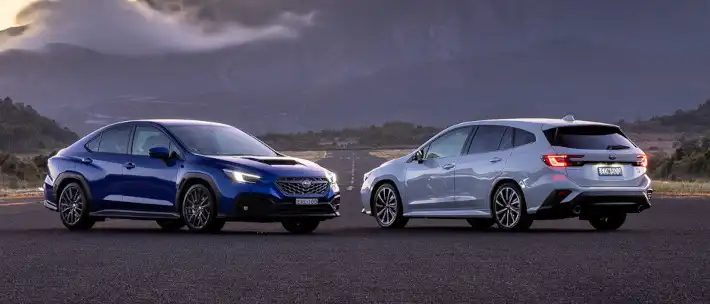While two of those formats are super straightforward, the difference between an AWD system and a 4WD (4x4) system can be a little bit trickier to get your head around.
As you’ll discover, cars, utes and SUVs are far more than four wheels and an engine, with a whole heap of wizardry going on below that we often take for granted, so let’s take a closer look at different drivetrain layouts and see how they translate on the road.
Get in touch with one of our Car Buying Specialists today.
Request a quote4WD / AWD / FWD / RWD: What’s the Difference?
Before we get into the nitty-gritty pros and cons of each, let’s cover the basics of exactly what a drivetrain does.
In short, the drivetrain uses power from the engine and delivers that to the wheels, with power thrown to either the front wheels, rear wheels or all four wheels.
-
Front-wheel drive (FWD) is by far the most common layout for passenger vehicles thanks to its simplicity, cost-effectiveness and user-friendly nature for more mundane everyday driving.
-
Rear-wheel drive (RWD) systems are used primarily for sportier packages and workhorses like utes, with power delivered solely to the rear wheels to improve handling while offering more traction at the rear for moving bulky loads.
-
Four-wheel Dive (4WD and 4x4) systems typically feature two driveshafts that power the front and rear wheels respectively, and can more than often drive via the rear wheels only thanks to a ‘part-time 4WD’ system, though others feature a full-time 4x4 system that keeps power constant.
-
All-wheel drive (AWD) systems are very similar to that of a 4WD drivetrain, however, they are typically locked into delivering constant power to all four wheels at the same time, though this isn’t always the case.
What’s the Difference Between 4WD and AWD?
The easiest way to visualise the difference between a vehicle with a four-wheel drive (4WD) layout and an all-wheel drive (AWD) system is that a 4x4 system is usually able to be turned off, powering the rear wheels most of the time, often to help out with fuel economy.
Yes, they both can power all four wheels at the same time, though all-wheel drive (AWD) vehicles are often locked into delivering constant power to all fours whereas a 4x4, can disconnect power to the front wheels and drive via the rears only.
What are the Pros & Cons of 4WD, AWD, FWD and RWD Systems?
Front-wheel Drive Pros
-
Affordability
-
Reduction of parts and complexity
-
Typically cheaper to service and maintain
-
Improved front wheel traction
-
User-friendly for cautious drivers
Front-wheel Drive Cons
-
Lacks ability in tougher conditions
-
Added weight over the front axle
-
Spirited driving results in understeer
Rear-wheel Drive Pros
-
Optimised handling and braking performance
-
Perfectly suited to spirited driving
-
Reduces understeer
-
More applicable for towing than FWD
Rear-wheel Drive Cons
-
Lacks rear traction in tougher conditions
-
Price premiums
-
Can impact interior space
4WD (4x4) Pros
-
Outstanding off-road performance
-
Ability to drive on via rear-wheels only
-
Perfect for towing
-
Traction in wet and challenging conditions
4WD (4x4) Cons
-
Less fuel-efficient than RWD & FWD
-
Added purchase price and maintenance costs
AWD Pros
-
Added confidence off-road
-
Traction in wet and challenging conditions
-
Efficient acceleration
AWD Cons
-
Some are locked into AWD permanently
-
Decreased fuel efficiency over FWD & RWD
-
Added purchase price and maintenance costs
FAQ: 4WD, AWD, FWD and RWD - What’s the Best?
The question of which is the best drivetrain layout depends largely on the type of vehicle that you’re purchasing, as well as how you plan on using your vehicle.
If you’re in the market for a simple, fuel-efficient and cost-effective commuter car, for example, a front-wheel drive layout is your cheapest option.
For those looking for a more agile sports car package or a part-time towing vehicle, a rear-wheel drive system adds rear traction and far more dynamic handling abilities.
If you’re planning on heading into the Great Outdoors, an AWD or 4WD vehicle is your best shout considering their four-paw traction that makes them your only option for any off-road driving.
FAQ: What is the Difference Between Low and High-Range?
Without getting bogged in the technicalities, a low and high-range transfer case allows you to dial in a super low gear ratio for the drivetrain if, for example, you’re hoping to conquer a steep incline.
This allows the engine to deliver constant power and torque at super-low speeds, with the help of a set of extra reduction gears, which is perfect for off-road applications that require a heap of power to tackle an aggressive gradient.
FAQ: How Do You Use Low-Range in a 4x4?
While specific steps will vary depending on your vehicle, typically the process of engaging the low-range gear ratio is to put the vehicle in park, turn the applicable dial from 4H (four-wheel drive high-range) to 4L (four-wheel drive low-range) and you’re good to go.
Remember to disengage the 4L setting when you’re finished with your off-road antics because the specialised gear ratio is not suitable for driving at speeds higher than 50km/h.
FAQ: What is the Most Fuel Efficient Drivetrain?
Typically, vehicles featuring a front-wheel drive (FWD) drivetrain are the most fuel-efficient of the bunch, which is largely thanks to their lower kerb weight figures than a rear-wheel drive vehicle, which receives a longer drive shaft and an additional differential at the rear.
These added components add weight which is the enemy of fuel efficiency, making the simpler and lighter FWD drivetrain the pick of the bunch when it comes to fuel economy.
Request a Quote
If you’re looking to get behind the wheel of a new car, be sure to reach out to one of our car-buying experts who can help find you the best possible price.
Get in touch with one of our Car Buying Specialists today.
Request a quote






